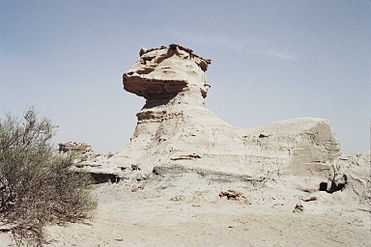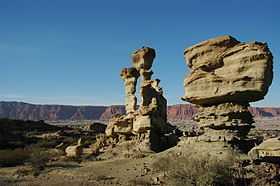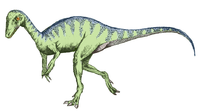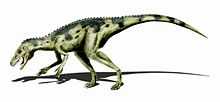Ischigualasto Provincial Park
| Ischigualasto Provincial Park | |
|---|---|
|
Parque Provincial Ischigualasto Valle de la Luna | |
|
The Submarine, wind-eroded rock formation | |
 Location in Argentina | |
| Location | San Juan Province, Argentina |
| Nearest city | San José de Jáchal |
| Coordinates | 30°4′0″S 68°0′0″W / 30.06667°S 68.00000°WCoordinates: 30°4′0″S 68°0′0″W / 30.06667°S 68.00000°W |
| Area | 60,370 ha (603.7 km2; 233.1 sq mi) |
| Established | November 3, 1971[1] |
| Official name |
Ischigualasto / Talampaya Natural Parks |
| Type | Natural |
| Criteria | viii |
| Designated | 2000 (24th session) |
| Reference no. | 966[2] |
| State Party |
|
| Region | Latin America and the Caribbean |
Ischigualasto Provincial Park (Spanish: Parque Provincial Ischigualasto), also called Valle de la Luna ("Valley of the Moon", due to its otherworldly appearance), is a provincial protected area in the north-east of San Juan Province, north-western Argentina, limiting to the north with the Talampaya National Park, in La Rioja Province. Both areas belong to the same geological formation, the Ischigualasto Formation (sometimes Ischigualasto-Talampaya Formation) Established on 3 November 1971,[1] the park has an area of 60,370 ha (603.7 km2; 233.1 sq mi)
In 2000 UNESCO included Ischigualasto and Talampaya National Park among its World Heritage Sites.[2]
History
The most accepted hypothesis gives the name "Ischigualasto" a Quechua origin, meaning "place where the moon sets", although some scholars have proposed Diaguita or Huarpe roots.
The first paleontological description of Ischigualasto dates from 1930. In 1941 the area was studied in more detail, which led to the discovery of 70 species of fossil plants. The region received for the first time the name Valle de la Luna in 1943, in a publication edited by the Automobil Club Argentino. That year, Dr. Ángel Cabrera of University of La Plata described the traversodontid Exaeretodon—the first cynodont found in Ischigualasto—after samples sent by a geologist who was doing prospecting for coal on behalf of an Argentine mining company.[3]
Academic work and geological prospecting proceeded slowly until 1958, when Dr. Alfred Sherwood Romer, a Harvard University expert in ancient mammals, discovered several rich fossil beds which he described as "extraordinary".
Description
Most of the park lies within the Valle Fértil Department, with a minor part in the Jachal Department of San Juan, at an altitude of about 1,300 m (4,300 ft) amsl. The park is part of the western border of the Central Sierras, and it features typical desert vegetation (bushes, cacti and some trees) which covers between 10 and 20% of the area. The climate is very dry, with rainfall mostly during the summer, and temperature extremes (minimum −10 °C (14 °F), maximum 45 °C (113 °F)). There is a constant southern wind with a speed of 20–40 km/h (12–25 mph) after noon and until the evening, sometimes accompanied by the extremely strong Zonda wind.
- Ischigualasto Provincial Park scenery
-
Las Coloradas cliff
-
Water-eroded badlands
-

The Sphynx, wind-eroded rock formation
-

The Mushroom, wind-eroded rock formation
Paleontology
The Ischigualasto Formation contains Late Triassic (Carnian) deposits (231.4 -225.9 million years before the present[4]), with some of the oldest known dinosaur remains, which are the world's first with regards to quality, number and importance. It is the only place in the world where nearly all of the Triassic is represented in an undisturbed sequence of rock deposits. This allows for the study of the transition between dinosaurs and ancient mammals; research is ongoing.
In the Carnian this area was a volcanically active floodplain dominated by rivers and had a strongly seasonal rainfall. Petrified tree trunks of Protojuniperoxylon ischigualastianus more than 40 m (130 ft) tall attest to a rich vegetation at that time. Fossil ferns and horsetails have also been found.
Rhynchosaurs and cynodonts (especially rhynchosaur Hyperodapedon and cynodont Exaeretodon[4]) are by far the predominant findings among the tetrapod fossils in the park. A study from 1993 found dinosaur specimens to comprise only 6% of the total tetrapod sample;[5] subsequent discoveries increased this number to approximately 11% of all findings.[4] Carnivorous dinosaurs are the most common terrestrial carnivores of the Ischigualasto Formation, with herrerasaurids comprising 72% of all recovered terrestrial carnivores.[4] Dinosaurs of Ischigualasto Formation include early samples of the two major lineages of dinosaurs (ornithischians and saurischians). The carnivorous archosaur Herrerasaurus is the most numerous of these dinosaur fossils. Another important putative dinosaur with primitive characteristics is Eoraptor lunensis, found in Ischigualasto in the early 1990s.
Dinosaurs
The fossils of an undescribed species of theropod are present in San Juan Province.[6]
Color key
|
Notes Uncertain or tentative taxa are in small text; |
| Dinosaurs of the Ischigualasto Formation | ||||||
|---|---|---|---|---|---|---|
| Genus | Species | Location | Stratigraphic position | Material | Notes | Images |
|
C. novasi |
San Juan Province[7] |
Cancha de Bochas Member[7] |
Partial skeleton including limb bones, pelvic bones and caudal vertebrae[7] |
Basal sauropodomorph closely related to Saturnalia[7] |
| |
|
E. murphi |
San Juan Province[4] |
Valle de la Luna Member |
A nearly complete skeleton and another partial skeleton |
Basal theropod | ||
|
E. lunensis[6] |
San Juan Province[6] |
Two nearly complete skeletons[8] |
Basal saurischian, possibly a theropod[7] or sauropodomorph[4] | |||
|
Frenguellisaurus[6] |
F. ischigualastensis[6] |
San Juan Province[6] |
Jr. synonym of Herrerasaurus ischigualastensis | |||
|
H. ischigualastensis[6] |
San Juan Province[6] |
"Various partial skeletons, including a complete skull and mandible."[8] |
A herrerasaurid, basal saurischian[7] or theropod[4] Includes Ischisaurus cattoi, Frenguellisaurus ischigualastensis, and cf. Staurikosaurus sp.[6] | |||
|
Ischisaurus[6] |
I. cattoi[6] |
San Juan Province[6] |
Jr. synonym of Herrerasaurus ischigualastensis | |||
|
P. protos[9] |
San Juan Province[6] |
One of the basalmost known genera of sauropodomorphs[7][9][10] | ||||
|
P. mertii[6] |
La Rioja Province[6] |
"Fragmentary skull and skeleton."[11] |
One of the earliest known ornithischians | |||
|
S. gordilloi |
San Juan Province[12] |
Cancha de Bochas Member[12] |
An incomplete skeleton[12] |
A herrerasaurid | ||
|
cf. Staurikosaurus |
Indeterminate |
San Juan Province[6] |
Remains previously referred to "cf. Staurikosaurus" were later determined to belong to Herrerasaurus[6] | |||
|
An unnamed herrerasaurian[7] |
Unnamed |
Specimen MACN-PV 18649a[7] |
A herrerasaurian distinct from Herrerasaurus, Staurikosaurus and Sanjuansaurus.[7] | |||
Other archosauromorphs
| Non-dinosaurian archosauromorphs of the Ischigualasto Formation[7][13] | ||||||
|---|---|---|---|---|---|---|
| Genus | Species | Location | Stratigraphic position | Material | Notes | Images |
|
A. scagliai |
An aetosaur |
|||||
|
I. fragilis[13] |
San Juan Province[13] |
Right ilium[13] |
||||
|
P. barrionuevoi |
||||||
|
Pseudochampsa[14] |
P. ischigualastensis[14] |
San Juan Province[15] |
Cancha de Bochas Member[15] |
An articulated incomplete skeleton[15] |
A proterochampsian. Originally described a species of Chanaresuchus,[15] subsequently made the type species of a separate genus Pseudochampsa.[14] | |
|
S. galilei |
||||||
|
Scaphonyx[13] |
S. sanjuanensis[13] |
A rhynchosaur. The species is assigned by some authors to the genus Hyperodapedon instead.[7] | ||||
|
S. longicervix |
||||||
|
T. romeri |
A putative basal crocodylomorph | |||||
|
V. rusconii[13] |
||||||
|
An unnamed lagerpetid[16][13] |
Unnamed |
Distal end of the left femur[13] |
||||
Synapsids
| Synapsids of the Ischigualasto Formation[7][13] | ||||||
|---|---|---|---|---|---|---|
| Genus | Species | Location | Stratigraphic position | Material | Notes | Images |
|
C. sanjuanensis, C. cf. theotonicus[13] |
A cynodont |
|||||
|
D. elegans |
San Juan Province |
Cancha de Bochas Member |
Partial skull, represented by the snout and the orbital region, with partially preserved upper dentition |
A cynodont | ||
|
E. lunensis |
A cynodont | |||||
|
E. frenguellii |
A cynodont | |||||
|
I.jenseni |
||||||
|
J. colorata[13] |
||||||
|
cf. Probainognathus |
Indeterminate |
A cynodont | ||||
|
An unnamed eucynodont[13] |
Unnamed[13] |
Specimen PVSJ 882 (a cranium)[13] |
||||
Other tetrapods
| Other tetrapods of the Ischigualasto Formation[7][13] | ||||||
|---|---|---|---|---|---|---|
| Genus | Species | Location | Stratigraphic position | Material | Notes | Images |
|
P. ischigualastensis |
A temnospondyl |
|||||
|
P. bellmanni |
A temnospondyl | |||||
See also
- List of dinosaur-bearing rock formations
References
- ↑ 1.0 1.1 Ley No. 3666 de la Provincia de San Juan, 11 de noviembre de 1971; sanc.: 3 de noviembre de 1971
- ↑ 2.0 2.1 "Ischigualasto / Talampaya Natural Parks". UNESCO World Heritage Centre.
- ↑ Cabrera 1943.
- ↑ 4.0 4.1 4.2 4.3 4.4 4.5 4.6 Martínez et al. 2011.
- ↑ Rogers et al. 1993.
- ↑ 6.0 6.1 6.2 6.3 6.4 6.5 6.6 6.7 6.8 6.9 6.10 6.11 6.12 6.13 6.14 6.15 6.16 6.17 6.18 6.19 Weishampel et al. 2004, pp. 527–528.
- ↑ 7.0 7.1 7.2 7.3 7.4 7.5 7.6 7.7 7.8 7.9 7.10 7.11 7.12 7.13 Ezcurra 2010.
- ↑ 8.0 8.1 Weishampel et al. 2004, p. 26, Table 2.1.
- ↑ 9.0 9.1 9.2 Martínez et al. 2009.
- ↑ Cabreira et al. 2011.
- ↑ Weishampel et al. 2004, p. 326, Table 14.1.
- ↑ 12.0 12.1 12.2 12.3 Alcober et al. 2010.
- ↑ 13.0 13.1 13.2 13.3 13.4 13.5 13.6 13.7 13.8 13.9 13.10 13.11 13.12 13.13 13.14 13.15 13.16 13.17 13.18 13.19 13.20 Martínez et al. 2013b.
- ↑ 14.0 14.1 14.2 Trotteyn & Ezcurra 2014.
- ↑ 15.0 15.1 15.2 15.3 Trotteyn et al. 2012.
- ↑ 16.0 16.1 Langer et al. 2013.
- ↑ Martínez et al. 2013.
Bibliography
Articles
- Cabrera, Ángel (1943), "El primer hallazgo de terápsidos en la Argentina", Notas del Museo de La Plata (in Spanish) 8: 317–331
- Rogers, Raymond R.; Swisher III, Carl C.; Sereno, Paul C.; Monetta, Alfredo M.; Forster, Catherine A.; Martínez, Ricardo N. (1993). "The Ischigualasto Tetrapod Assemblage (Late Triassic, Argentina) and 40Ar/39Ar Dating of Dinosaur Origins". Science 260 (5109): 794–797. doi:10.1126/science.260.5109.794. PMID 17746113.
- Martínez, Ricardo N.; Alcober, Oscar A. (2009). "A Basal Sauropodomorph (Dinosauria: Saurischia) from the Ischigualasto Formation (Triassic, Carnian) and the Early Evolution of Sauropodomorpha". PLoS ONE 4 (2): e4397. doi:10.1371/journal.pone.0004397. PMC 2635939. PMID 19209223.
- Alcober, Oscar A.; Martinez, Ricardo N. (2010). "A new herrerasaurid (Dinosauria, Saurischia) from the Upper Triassic Ischigualasto Formation of northwestern Argentina". ZooKeys 63: 55–81. doi:10.3897/zookeys.63.550. PMC 3088398. PMID 21594020.
- Ezcurra, Martín D. (2010). "A new early dinosaur (Saurischia: Sauropodomorpha) from the Late Triassic of Argentina: a reassessment of dinosaur origin and phylogeny". Journal of Systematic Palaeontology 8: 371–425. doi:10.1080/14772019.2010.484650.
- Cabreira, Sergio F.; Schultz, Cesar L.; Bittencourt, Jonathas S.; Soares, Marina B.; Fortier, Daniel C.; Silva, Lúcio R.; Langer, Max C. (2011). "New stem-sauropodomorph (Dinosauria, Saurischia) from the Triassic of Brazil". Naturwissenschaften 98 (12): 1035–1040. doi:10.1007/s00114-011-0858-0. PMID 22083251.
- Martínez, Ricardo N.; Sereno, Paul C.; Alcober, Oscar A.; Colombi, Carina E.; Renne, Paul R.; Montañez, Isabel P.; Currie, Brian S. (2011). "A Basal Dinosaur from the Dawn of the Dinosaur Era in Southwestern Pangaea". Science 331 (6014): 206–210. doi:10.1126/science.1198467. PMID 21233386.
- Trotteyn, María J.; Martínez, Ricardo N.; Alcober, Oscar A. (2012). "A new proterochampsid Chanaresuchus ischigualastensis (Diapsida, Archosauriformes) in the early Late Triassic Ischigualasto Formation, Argentina". Journal of Vertebrate Paleontology 32 (2): 485–489. doi:10.1080/02724634.2012.645975.
- Martínez, Ricardo N.; Fernández, Eliana; Alcober, Oscar A. (2013). "A new non-mammaliaform eucynodont from the Carnian-Norian Ischigualasto Formation, Northwestern Argentina". Revista Brasileira de Paleontologia 16 (1): 61–76. doi:10.4072/rbp.2013.1.05.
- Martínez, Ricardo N.; Apaldetti, Cecilia; Alcober, Oscar A.; Colombi, Carina E.; Sereno, Paul C.; Fernández, Eliana; Santi Malnis, Paula; Correa, Gustavo A.; Abelin, Diego (2013). "Vertebrate succession in the Ischigualasto Formation". Journal of Vertebrate Paleontology. Memoir 12: Basal sauropodomorphs and the vertebrate fossil record of the Ischigualasto Formation (Late Triassic: Carnian-Norian) of Argentina: 10–30. doi:10.1080/02724634.2013.818546.
- Trotteyn, María Jimena; Ezcurra, Martín D. (2014). "Osteology of Pseudochampsa ischigualastensis gen. et comb. nov. (Archosauriformes: Proterochampsidae) from the Early Late Triassic Ischigualasto Formation of Northwestern Argentina". PLoS ONE 9 (11): e111388. doi:10.1371/journal.pone.0111388.
Books
- Langer, Max C.; Nesbitt, Sterling J.; Bittencourt, Jonathas S.; Irmis, Randall B. (2013). "Non-dinosaurian Dinosauromorpha". In Nesbitt, S. J.; Desojo, J. B.; Irmis, R. B. Anatomy, phylogeny and palaeobiology of early archosaurs and their kin. The Geological Society of London. pp. 157–186. doi:10.1144/SP379.9.
- Weishampel, David B.; Dodson, Peter; Osmólska, Halszka (2004). The Dinosauria (2 ed.). University of California Press. ISBN 0-520-24209-2.
External links
| Wikimedia Commons has media related to Parque Provincial de Ischigualasto. |
- Ischigualasto at Ente Autárquico Ischigualasto (official website, in Spanish)
- UNESCO World Heritage Centre – Description of the Ischigualasto-Talampaya site at UNESCO
- Localities of the Triassic: Ischigualasto Formation, Argentina at University of California Museum of Paleontology
- Parque Provincial Ischigualasto at La HueYa (in Spanish)
- Valle de la Luna – Ischigualasto at ArgentinaXplora (in Spanish)
- Pictures from Valle de la Luna at
| |||||||||||||||||||||||||||||








